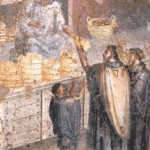by Tracy Barrett, W&M contributor
Ah, the joys of research. You find exactly the detail you need to round out a character’s personality, or an artifact that will enable your plot to develop in the way that you want. Or you stumble upon something that you hadn’t been looking for, but which takes you in a direction that you hadn’t thought of but that enriches your manuscript. There’s a flip side, of course. Some integral object turns out to have been invented centuries after the time when your story is based, or a character died before she could have met your protagonist.
And then there are the wonderful, quirky details you can’t use. They’re irrelevant or distracting. It’s so hard to let them go, reluctantly watching a weird item float away because you just can’t work them into your story.
I recently found one of those, and although I haven’t given up, I’m still trying to figure out a way to use it.
Most ancient history buffs know about garum—the sauce made of fermented fish (guts included) that the Romans were addicted to. It was stinky stuff. (But loaded with umami, it turns out.)
Despite their love for it, the Romans forbade its manufacture within city walls. It’s so pungent that when some jars labeled “GARUM” were opened after lying on the sea bed for millennia, they reputedly still smelled of it. The city of Pompeii was well known for its high-quality garum.
 Being a port, Pompeii was also a very multicultural city. Its merchants catered to customers from a wide variety of cultures, many of whom observed specific dietary laws. When some jars of garum labeled “castum” (pure) were found, scholars wondered—pure in what sense?
Being a port, Pompeii was also a very multicultural city. Its merchants catered to customers from a wide variety of cultures, many of whom observed specific dietary laws. When some jars of garum labeled “castum” (pure) were found, scholars wondered—pure in what sense?
At least some scholars believe it means “kosher.”
Kosher garum! How can I work it into my story? The last thing I want to do is to use it for its own sake. That always winds up being clunky. I recently tried to read a novel set in the Middle Ages and gave up after too many passages like this one:
Janekin had been engaged in a battle of words with the young citizens who supported Henry, duke of Lancaster, in his struggle with King Richard. Janekin was of the king’s party and wore a pewter badge of the white hart in his tall hat of felt. John of Gaunt, father of Henry, had died seven weeks before. Now King Richard had revoked Henry’s inheritance, keeping the Lancastrian legacy for his own use, and had consigned Henry to perpetual banishment. Janekin had been watching some Lancastrian supporters at the corner of Ave Maria Lane, and had called out “Torphut! Torphut!” as a signal of his contempt. Two of them heard this and ran in chase of Janekin, who turned upon his heels and fled down the lane.
Now, I’m all for period detail to add richness to a scene. The pewter badge in a tall felt hat is a nice touch—I hadn’t pictured Janekin in a tall hat until then. Ave Maria Lane is a nice name. But it goes into overload. Do we really need to know the details of the tussle for the throne? And what the heck is “torphut”? Okay, I get that it’s an insult. But what does it mean?
The OED didn’t help. A google search turned up only this same passage. I have no doubt that the author found the word in some document someplace and it had such a nice insulting sound that he just had to use it.
It didn’t work for me—it pulls me out of the story. I wish he had resisted the impulse and had found another insult to use.
So from now on I’m going to call those interesting facts that you’re dying to use but really shouldn’t “torphuts.” And I vow to avoid them.


